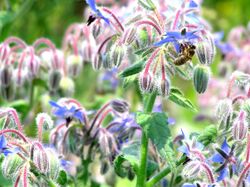Biology:Boraginoideae
| Boraginoideae | |
|---|---|

| |
| Borago officinalis | |
| Scientific classification | |
| Kingdom: | Plantae |
| Clade: | Tracheophytes |
| Clade: | Angiosperms |
| Clade: | Eudicots |
| Clade: | Asterids |
| Order: | Boraginales |
| Family: | Boraginaceae |
| Subfamily: | Boraginoideae Arn. |
| Type genus | |
| Borago L.
| |
| Tribes | |
| |
Boraginoideae is a subfamily of the plant family Boraginaceae s.s, with about 42 genera. That family is defined in a much broader sense (Boraginaceae s.l.) in the Angiosperm Phylogeny Group (APG) system of classification for flowering plants. The APG has not specified any subfamilial structure within Boraginaceae s.l.
Taxonomy
Some taxonomists placed the genera Codon and Wellstedia in Boraginoideae. Others place one or both of these in separate, monogeneric subfamilies. Codon was long regarded as an odd member of Hydrophylloideae, but in 1998, a molecular phylogenetic study suggested that it is closer to Boraginoideae.[1] Neither is included n more modern classifications.[2]
Some authors proposed a revision of earlier APG systems, in which Boraginaceae had been included as an unplaced family (i.e. not included in a specified order) within the lamiid clade of eudicots. In that system. Boraginaceae was defined broadly (Boraginaceae sensu lato or s.l.). Instead they proposed recognizing five to eight families in a separate order, the Boraginales.[3][2] In that system Boraginaceae is treated in a narrow sense (sensu stricto or s.s.). Subsequently the order Boraginales was added to the 2016 revision (APG IV) to include Boraginaceae at the ordinal level, in which it was the sole family. The consensus was to continue the broad usage rather than split it into separate families, based on its monophyletic composition.[4] The subfamilial structure applies solely to Boraginaceae s.s., which includes around 1,600 to 1,700 species divided into some 90 genera.[citation needed]
Subdivision
Comparisons of DNA sequences by cladistic methods suggested the division of Boraginoideae into four tribes: Echiochileae, Boragineae, Lithospermeae, and Cynoglosseae.[5] This was subsequently resolved into only two tribes, Boragineae and Lithospermeae (25 genera). Boragineae was then further subdivided into two subtribes, Boragininae (15 genera) and Moritziinae (2).[2]
Genera
Genera and approximate number of species in the system of Chacon et al (2016):[2]
- Tribe Boragineae
- Subtribe Boragininae (140 species)
Anchusa, Anchusella, Borago, Brunnera, Cynoglottis, Gastrocotyle, Hormuzakia, Lycopsis, Melanortocarya, Nonea, Pentaglottis, Phyllocara, Pulmonaria, Symphytum, Trachystemon
- Subtribe Moritziinae (6 species)
Moritzia, Thaumatocaryon
- Tribe Lithospermeae (460 species)
Aegonychon, Alkanna, Ancistrocarya, Arnebia, Buglossoides, Cerinthe, Cystostemon, Echiostachys, Echium, Glandora, Halacsya, Huynhia, Lithodora, Lithospermum, Lobostemon, Maharanga, Mairetis, Moltkia, Moltkiopsis, Neatostema, Onosma, Paramoltkia, Podonosma, Pontechium, Stenosolenium.[6]
The following list of genera consists of Codon plus the genera listed for Boraginoideae at the Germplasm Resources Information Network[7]
References
- ↑ Ferguson 1998.
- ↑ 2.0 2.1 2.2 2.3 Chacon et al 2016.
- ↑ Weigand et al 2014.
- ↑ Peter F. Stevens. (2001 onwards). "Boraginaceae". At: Angiosperm Phylogeny Website. At: Missouri Botanical Garden Website. (see External links below)
- ↑ Cohen 2014.
- ↑ Armen Takhtajan Flowering Plants (2009) , p. 542, at Google Books
- ↑ "Genera of Boraginaceae subfam. Boraginoideae". Germplasm Resources Information Network. United States Department of Agriculture. http://www.ars-grin.gov/cgi-bin/npgs/html/gnlist.pl?2089.
Bibliography
- Chacón, Juliana; Luebert, Federico; Hilger, Hartmut H.; Ovchinnikova, Svetlana; Selvi, Federico; Cecchi, Lorenzo; Guilliams, C. Matt; Hasenstab-Lehman, Kristen et al. (24 June 2016). "The borage family (Boraginaceae s.str.): A revised infrafamilial classification based on new phylogenetic evidence, with emphasis on the placement of some enigmatic genera". Taxon 65 (3): 523–546. doi:10.12705/653.6. https://www.researchgate.net/publication/304454123.
- Cohen, James I. (April 2014). "A phylogenetic analysis of morphological and molecular characters of Boraginaceae: evolutionary relationships, taxonomy, and patterns of character evolution". Cladistics 30 (2): 139–169. doi:10.1111/cla.12036. PMID 34784688.
- Ferguson, Diane M. (July 1998). "Phylogenetic Analysis and Relationships in Hydrophyllaceae Based on ndhF Sequence Data". Systematic Botany 23 (3): 253–268. doi:10.2307/2419504.
- Weigend, Maximilian; Luebert, Federico; Gottschling, Marc; Couvreur, Thomas L.P.; Hilger, Hartmut H.; Miller, James S. (October 2014). "From capsules to nutlets-phylogenetic relationships in the Boraginales". Cladistics 30 (5): 508–518. doi:10.1111/cla.12061. PMID 34794245.
- Distribution Map And Genus list At Boraginaceae At Boraginales At: Trees At: APweb At: Missouri Botanical Garden
Wikidata ☰ Q530442 entry
 |

